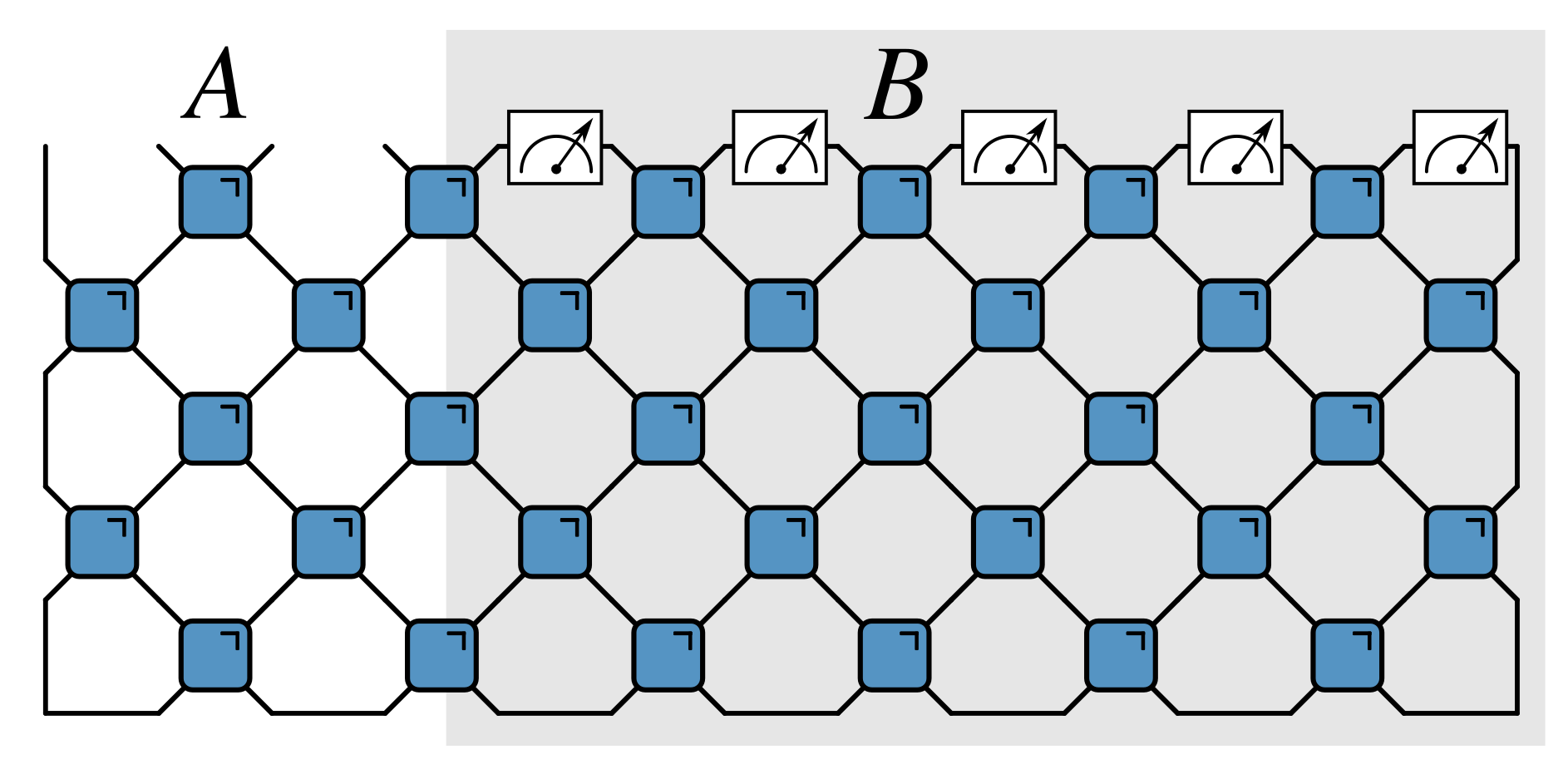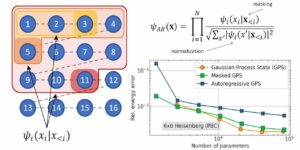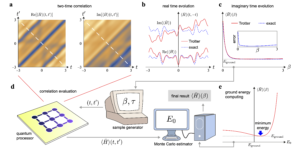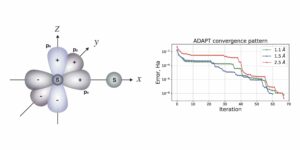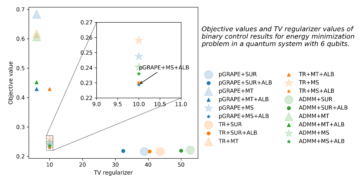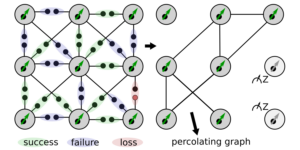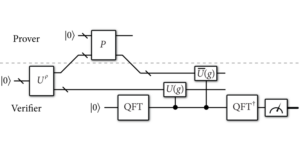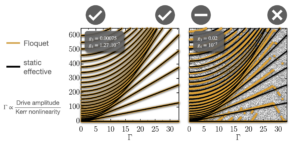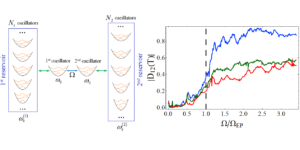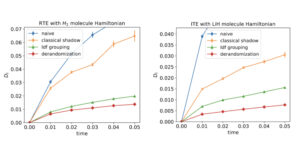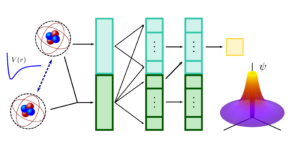1Max Planck Institute for the Physics of Complex Systems, 01187 Dresden, Germany
2TCM Group, Cavendish Laboratory, University of Cambridge, Cambridge CB3 0HE, UK
Se vam zdi ta članek zanimiv ali želite razpravljati? Zaslišite ali pustite komentar na SciRate.
Minimalizem
Recent works have investigated the emergence of a new kind of random matrix behaviour in unitary dynamics following a quantum quench. Starting from a time-evolved state, an ensemble of pure states supported on a small subsystem can be generated by performing projective measurements on the remainder of the system, leading to a $textit{projected ensemble}$. In chaotic quantum systems it was conjectured that such projected ensembles become indistinguishable from the uniform Haar-random ensemble and lead to a $textit{quantum state design}$. Exact results were recently presented by Ho and Choi [Phys. Rev. Lett. 128, 060601 (2022)] for the kicked Ising model at the self-dual point. We provide an alternative construction that can be extended to general chaotic dual-unitary circuits with solvable initial states and measurements, highlighting the role of the underlying dual-unitarity and further showing how dual-unitary circuit models exhibit both exact solvability and random matrix behaviour. Building on results from biunitary connections, we show how complex Hadamard matrices and unitary error bases both lead to solvable measurement schemes.
Featured image: Schematic illustration of a quantum circuit for which measurements on the observed subsystem B return random states on the unobserved subsystem A.
Priljubljen povzetek
For this approach to work the state must have a high degree of entanglement between the two subsystems. On the other hand, feasible experimental realisations must be local: formed by operations on neighbouring qubits, for example. In this paper we show that a recently introduced family of quantum circuits made from dual-unitary gates provides precisely the necessary ingredients to build arbitrarily random quantum states by the method of partial measurements. Besides potential applications to benchmarking of quantum computers, our results provide a detailed view of the quantum chaotic properties of the wavefunctions of an extended system.
► BibTeX podatki
► Reference
[1] L. D'Alessio, Y. Kafri, A. Polkovnikov in M. Rigol, Adv. Phys. 65, 239 (2016).
https: / / doi.org/ 10.1080 / 00018732.2016.1198134
[2] H.-J. Stöckmann, Quantum Chaos: An Introduction (Cambridge University Press, Cambridge, 1999).
https: / / doi.org/ 10.1017 / CBO9780511524622
[3] F. Haake, Quantum Signatures of Chaos, Springer Series in Synergetics, Vol. 54 (Springer Berlin Heidelberg, Berlin, Heidelberg, 2010).
https://doi.org/10.1007/978-3-642-05428-0
[4] M. Akila, D. Waltner, B. Gutkin, and T. Guhr, J. Phys. A: Math. Theor. 49, 375101 (2016).
https://doi.org/10.1088/1751-8113/49/37/375101
[5] B. Bertini, P. Kos, and T. Prosen, Phys. Rev. Lett. 121, 264101 (2018).
https: / / doi.org/ 10.1103 / PhysRevLett.121.264101
[6] B. Bertini, P. Kos, and T. Prosen, Phys. Rev. X 9, 021033 (2019a).
https: / / doi.org/ 10.1103 / PhysRevX.9.021033
[7] S. Gopalakrishnan and A. Lamacraft, Phys. Rev. B 100, 064309 (2019).
https: / / doi.org/ 10.1103 / PhysRevB.100.064309
[8] B. Bertini, P. Kos, and T. Prosen, Phys. Rev. Lett. 123, 210601 (2019b).
https: / / doi.org/ 10.1103 / PhysRevLett.123.210601
[9] S. A. Rather, S. Aravinda, and A. Lakshminarayan, Phys. Rev. Lett. 125, 070501 (2020).
https: / / doi.org/ 10.1103 / PhysRevLett.125.070501
[10] B. Gutkin, P. Braun, M. Akila, D. Waltner, and T. Guhr, Phys. Rev. B 102, 174307 (2020).
https: / / doi.org/ 10.1103 / PhysRevB.102.174307
[11] S. Aravinda, S. A. Rather, and A. Lakshminarayan, Phys. Rev. Research 3, 043034 (2021).
https: / / doi.org/ 10.1103 / PhysRevResearch.3.043034
[12] P. W. Claeys and A. Lamacraft, Phys. Rev. Lett. 126, 100603 (2021).
https: / / doi.org/ 10.1103 / PhysRevLett.126.100603
[13] T. Prosen, Chaos 31, 093101 (2021).
https: / / doi.org/ 10.1063 / 5.0056970
[14] S. Singh and I. Nechita, arXiv:2112.11123 (2021).
https: / / doi.org/ 10.1088 / 1751-8121 / ac7017
arXiv: 2112.11123v1
[15] M. Borsi and B. Pozsgay, arXiv:2201.07768 (2022).
arXiv: 2201.07768
[16] P. W. Claeys and A. Lamacraft, Phys. Rev. Research 2, 033032 (2020).
https: / / doi.org/ 10.1103 / PhysRevResearch.2.033032
[17] B. Bertini and L. Piroli, Phys. Rev. B 102, 064305 (2020).
https: / / doi.org/ 10.1103 / PhysRevB.102.064305
[18] R. Suzuki, K. Mitarai, and K. Fujii, Quantum 6, 631 (2022).
https://doi.org/10.22331/q-2022-01-24-631
[19] L. Piroli, B. Bertini, J. I. Cirac, and T. Prosen, Phys. Rev. B 101, 094304 (2020).
https: / / doi.org/ 10.1103 / PhysRevB.101.094304
[20] B. Jonnadula, P. Mandayam, K. Życzkowski, and A. Lakshminarayan, Phys. Rev. Research 2, 043126 (2020).
https: / / doi.org/ 10.1103 / PhysRevResearch.2.043126
[21] I. Reid and B. Bertini, Phys. Rev. B 104, 014301 (2021).
https: / / doi.org/ 10.1103 / PhysRevB.104.014301
[22] P. Kos, B. Bertini, and T. Prosen, Phys. Rev. X 11, 011022 (2021a).
https: / / doi.org/ 10.1103 / PhysRevX.11.011022
[23] A. Lerose, M. Sonner, and D. A. Abanin, Phys. Rev. X 11, 021040 (2021).
https: / / doi.org/ 10.1103 / PhysRevX.11.021040
[24] G. Giudice, G. Giudici, M. Sonner, J. Thoenniss, A. Lerose, D. A. Abanin, and L. Piroli, Phys. Rev. Lett. 128, 220401 (2022).
https: / / doi.org/ 10.1103 / PhysRevLett.128.220401
[25] A. Lerose, M. Sonner, and D. A. Abanin, arXiv:2201.04150 (2022).
arXiv: 2201.04150
[26] A. Zabalo, M. Gullans, J. Wilson, R. Vasseur, A. Ludwig, S. Gopalakrishnan, D. A. Huse, and J. Pixley, Phys. Rev. Lett. 128, 050602 (2022).
https: / / doi.org/ 10.1103 / PhysRevLett.128.050602
[27] E. Chertkov, J. Bohnet, D. Francois, J. Gaebler, D. Gresh, A. Hankin, K. Lee, R. Tobey, D. Hayes, B. Neyenhuis, R. Stutz, A. C. Potter, and M. Foss-Feig, arXiv:2105.09324 (2021).
arXiv: 2105.09324
[28] X. Mi, P. Roushan, C. Quintana, S. Mandrà, J. Marshall, C. Neill, F. Arute, K. Arya, J. Atalaya, R. Babbush, J. C. Bardin, R. Barends, J. Basso, A. Bengtsson, S. Boixo, A. Bourassa, M. Broughton, B. B. Buckley, D. A. Buell, B. Burkett, N. Bushnell, Z. Chen, B. Chiaro, R. Collins, W. Courtney, S. Demura, A. R. Derk, A. Dunsworth, D. Eppens, C. Erickson, E. Farhi, A. G. Fowler, B. Foxen, C. Gidney, M. Giustina, J. A. Gross, M. P. Harrigan, S. D. Harrington, J. Hilton, A. Ho, S. Hong, T. Huang, W. J. Huggins, L. B. Ioffe, S. V. Isakov, E. Jeffrey, Z. Jiang, C. Jones, D. Kafri, J. Kelly, S. Kim, A. Kitaev, P. V. Klimov, A. N. Korotkov, F. Kostritsa, D. Landhuis, P. Laptev, E. Lucero, O. Martin, J. R. McClean, T. McCourt, M. McEwen, A. Megrant, K. C. Miao, M. Mohseni, S. Montazeri, W. Mruczkiewicz, J. Mutus, O. Naaman, M. Neeley, M. Newman, M. Y. Niu, T. E. O’Brien, A. Opremcak, E. Ostby, B. Pato, A. Petukhov, N. Redd, N. C. Rubin, D. Sank, K. J. Satzinger, V. Shvarts, D. Strain, M. Szalay, M. D. Trevithick, B. Villalonga, T. White, Z. J. Yao, P. Yeh, A. Zalcman, H. Neven, I. Aleiner, K. Kechedzhi, V. Smelyanskiy, and Y. Chen, Science (2021), 10.1126/science.abg5029.
https://doi.org/ 10.1126/science.abg5029
[29] B. Bertini, P. Kos, and T. Prosen, Commun. Math. Phys. 387, 597 (2021).
https://doi.org/10.1007/s00220-021-04139-2
[30] P. Kos, B. Bertini, and T. Prosen, Phys. Rev. Lett. 126, 190601 (2021b).
https: / / doi.org/ 10.1103 / PhysRevLett.126.190601
[31] F. Fritzsch and T. Prosen, Phys. Rev. E 103, 062133 (2021).
https: / / doi.org/ 10.1103 / PhysRevE.103.062133
[32] J. S. Cotler, D. K. Mark, H.-Y. Huang, F. Hernandez, J. Choi, A. L. Shaw, M. Endres, and S. Choi, arXiv:2103.03536 (2021).
arXiv: 2103.03536
[33] J. Choi, A. L. Shaw, I. S. Madjarov, X. Xie, J. P. Covey, J. S. Cotler, D. K. Mark, H.-Y. Huang, A. Kale, H. Pichler, F. G. S. L. Brandão, S. Choi, and M. Endres, arXiv:2103.03535 (2021).
arXiv: 2103.03535
[34] W. W. Ho and S. Choi, Phys. Rev. Lett. 128, 060601 (2022).
https: / / doi.org/ 10.1103 / PhysRevLett.128.060601
[35] D. Gross, K. Audenaert in J. Eisert, J. Math. Phys. 48, 052104 (2007).
https: / / doi.org/ 10.1063 / 1.2716992
[36] A. Ambainis and J. Emerson, in Twenty-Second Annual IEEE Conference on Computational Complexity (CCC’07) (2007) pp. 129–140, iSSN: 1093-0159.
https: / / doi.org/ 10.1109 / CCC.2007.26
[37] D. A. Roberts and B. Yoshida, J. High Energ. Phys. 2017, 121 (2017).
https: / / doi.org/ 10.1007 / JHEP04 (2017) 121
[38] H. Wilming and I. Roth, arXiv:2202.01669 (2022).
arXiv: 2202.01669
[39] D. J. Reutter and J. Vicary, Higher Structures 3, 109 (2019).
https:///doi.org/10.48550/arXiv.1609.07775
[40] A. Chandran and C. R. Laumann, Phys. Rev. B 92, 024301 (2015).
https: / / doi.org/ 10.1103 / PhysRevB.92.024301
[41] A. Nahum, J. Ruhman, S. Vijay, and J. Haah, Phys. Rev. X 7, 031016 (2017).
https: / / doi.org/ 10.1103 / PhysRevX.7.031016
[42] V. Khemani, A. Vishwanath, and D. A. Huse, Phys. Rev. X 8, 031057 (2018).
https: / / doi.org/ 10.1103 / PhysRevX.8.031057
[43] C. von Keyserlingk, T. Rakovszky, F. Pollmann, and S. Sondhi, Phys. Rev. X 8, 021013 (2018).
https: / / doi.org/ 10.1103 / PhysRevX.8.021013
[44] A. Nahum, S. Vijay in J. Haah, Phys. Rev. X 8, 021014 (2018).
https: / / doi.org/ 10.1103 / PhysRevX.8.021014
[45] A. Chan, A. De Luca, and J. Chalker, Phys. Rev. X 8, 041019 (2018).
https: / / doi.org/ 10.1103 / PhysRevX.8.041019
[46] T. Rakovszky, F. Pollmann, and C. von Keyserlingk, Phys. Rev. X 8, 031058 (2018).
https: / / doi.org/ 10.1103 / PhysRevX.8.031058
[47] T. Rakovszky, F. Pollmann, and C. von Keyserlingk, Phys. Rev. Lett. 122, 250602 (2019).
https: / / doi.org/ 10.1103 / PhysRevLett.122.250602
[48] T. Zhou and A. Nahum, Phys. Rev. X 10, 031066 (2020).
https: / / doi.org/ 10.1103 / PhysRevX.10.031066
[49] S. Garratt and J. Chalker, Phys. Rev. X 11, 021051 (2021).
https: / / doi.org/ 10.1103 / PhysRevX.11.021051
[50] J. Bensa and M. Žnidarič, Phys. Rev. X 11, 031019 (2021).
https: / / doi.org/ 10.1103 / PhysRevX.11.031019
[51] R. Orús, Ann. Phys. 349, 117 (2014).
https: / / doi.org/ 10.1016 / j.aop.2014.06.013
[52] B. Bertini, P. Kos, and T. Prosen, SciPost Phys. 8, 067 (2020a).
https: / / doi.org/ 10.21468 / SciPostPhys.8.4.067
[53] D. Weingarten, J. Math. Phys. 19, 999 (1978).
https: / / doi.org/ 10.1063 / 1.523807
[54] B. Collins, Int. Math. Res. Not. 2003, 953 (2003).
https: / / doi.org/ 10.1155 / S107379280320917X
[55] B. Collins and P. Śniady, Commun. Math. Phys. 264, 773 (2006).
https://doi.org/10.1007/s00220-006-1554-3
[56] B. Bertini, P. Kos, and T. Prosen, SciPost Phy. 8, 068 (2020b).
https: / / doi.org/ 10.21468 / SciPostPhys.8.4.068
[57] Z. Webb, QIC 16, 1379 (2016).
https: / / doi.org/ 10.26421 / QIC16.15-16-8
[58] E. Knill, Non-binary unitary error bases and quantum codes, Tech. Rep. LA-UR-96-2717 (Los Alamos National Lab. (LANL), Los Alamos, NM (United States), 1996).
https: / / doi.org/ 10.2172 / 373768
[59] P. Shor, in Proceedings of 37th Conference on Foundations of Computer Science (1996) pp. 56–65, iSSN: 0272-5428.
https: / / doi.org/ 10.1109 / SFCS.1996.548464
[60] R. F. Werner, J. Phys. A: Math. Gen. 34, 7081 (2001).
https://doi.org/10.1088/0305-4470/34/35/332
[61] J. Hauschild and F. Pollmann, SciPost Phys. Lect. Notes , 005 (2018).
https: / / doi.org/ 10.21468 / SciPostPhysLectNotes
[62] Y. Li, X. Chen, and M. P. A. Fisher, Phys. Rev. B 98, 205136 (2018).
https: / / doi.org/ 10.1103 / PhysRevB.98.205136
[63] B. Skinner, J. Ruhman, and A. Nahum, Phys. Rev. X 9, 031009 (2019).
https: / / doi.org/ 10.1103 / PhysRevX.9.031009
[64] A. Chan, R. M. Nandkishore, M. Pretko, and G. Smith, Phys. Rev. B 99, 224307 (2019).
https: / / doi.org/ 10.1103 / PhysRevB.99.224307
[65] M. J. Gullans and D. A. Huse, Phys. Rev. X 10, 041020 (2020).
https: / / doi.org/ 10.1103 / PhysRevX.10.041020
[66] M. Ippoliti and W. W. Ho, arXiv:2204.13657 (2022).
arXiv: 2204.13657
Navedel
[1] Matteo Ippoliti and Wen Wei Ho, “Dynamical purification and the emergence of quantum state designs from the projected ensemble”, arXiv: 2204.13657.
[2] Suhail Ahmad Rather, S. Aravinda, and Arul Lakshminarayan, “Construction and local equivalence of dual-unitary operators: from dynamical maps to quantum combinatorial designs”, arXiv: 2205.08842.
Zgornji citati so iz SAO / NASA ADS (zadnjič posodobljeno 2022-07-16 14:31:19). Seznam je morda nepopoln, saj vsi založniki ne dajejo ustreznih in popolnih podatkov o citiranju.
On Crossref je navedel storitev ni bilo najdenih podatkov o navajanju del (zadnji poskus 2022-07-16 14:31:18).
Ta dokument je objavljen v Quantumu pod Priznanje avtorstva Creative Commons 4.0 International (CC BY 4.0) licenca. Avtorske pravice ostajajo pri izvirnih imetnikih avtorskih pravic, kot so avtorji ali njihove ustanove.

